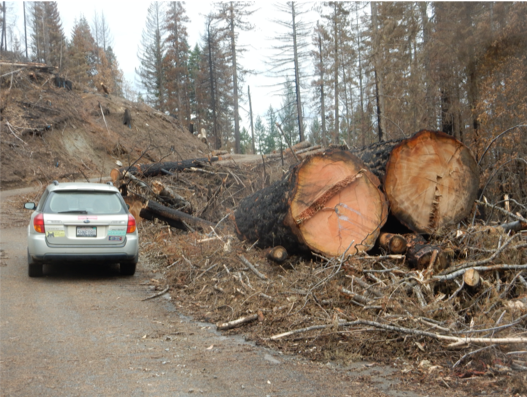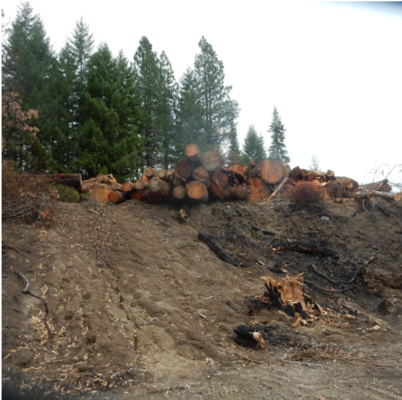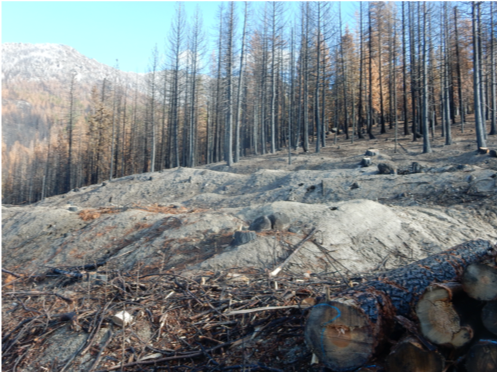By Felice Pace
North Group
*A previous edition of this article appeared in EcoNews.
I have sometimes wondered if the U.S. Forest Service has an evil genie locked in a windowless office in Washington, D.C., tasked with thinking up new reasons to log our national forests. And while an evil genie is probably unlikely, the agency has yet again come up with a new logging loophole. Here’s how it goes:
Toward the end of a wildfire, Forest Service managers select a national forest road within the fire area, which they say they must keep open for public access to trailheads and other recreation sites. Then they define all trees that are over a certain diameter and within one tree length of the road (about 40 yards) as “hazard trees,” which they then say must be removed to protect the public while maintaining public access. At this point it is usually difficult to determine which trees are alive or dead.
The logging is accomplished using off-budget firefighting funds, while claiming categorical exclusions from environmental analysis and review. The result is linear clearcuts up to a half-mile long on both sides of selected roads. Both green and dead trees are felled, limbs are removed and the logs are dragged to the edges of the road where they are piled for a timber sale.
Because our large fires are never extinguished until the coming of fall rains, the “hazard tree” logging takes place early in the wet season resulting in large amounts of disturbed soil being placed into positions where it is certain to erode over the winter wet period, delivering fine, salmon-killing sediment to streams, which should be serving as refugia for at risk salmonids.
Wildfire logging and its impacts
The new Forest Service logging opportunity was practiced at least twice on the Klamath National Forest during October 2021. At the end of the McCash Fire, logging was approved on the Ti Bar Road, route 14N01, in the vicinity of Ten Bear Mountain, a site on the Ukonom Ranger district of the Klamath National Forest but administered by the Six Rivers National Forest. Similarly toward the end of the Haypress Fire, the Klamath National Forest approved logging along national forest route 40N17, within the South Fork Scott Watershed.
Both logging sites are in highly erodible decomposed granitic soil, also known as DG. Photos of both sites show large amount of disturbed DG soil positioned where it is likely to erode massively this winter.
Forest Service managers who approved the logging know that most trees in locations downslope of roads will fall away from the road and are therefore not “hazards” to those traveling the roads. Those managers also know that most large fire-killed trees will not begin to fall for five to eight years. Thus any substantial “hazard” from trees along these roads is years in the future, and can be addressed on a case by case basis when appropriate.
Bottom line is that there was ample time for environmental review of plans to remove “hazard trees” along forest roads 14N01 and 40N17, but the Forest Service instead elected to avoid environmental analysis via the “hazard tree” loophole.

Old Growth logged without environmental review along Ti Bar Road. Note the eroding
bank above the vehicle and loose soil deposited along the road’s outboard edge.

Logging and soil disturbance along Ti Bar Road, national forest route 14N01.
Note the rills and gullies already developing in October before the main wet season.

Decomposed granitic soil disturbed during logging at the end of the
Haypress Wildfire and perched for erosion over the winter wet season.

Logging below Road 40N17 in the South Fork Scott Watershed. Note the erosion track already crossing the road even before the rains come in earnest.
A new brand of Forest Service cynicism
In these two cases, logging is also a direct and substantial threat to important salmon refugia and, therefore, a direct negative impact to threatened Coho and Spring Chinook salmon that find refugia in Ti Bar Creek and the South Fork Scott River. By smothering salmon nests and habitat with fine soil over the winter and early spring, this logging will likely result in “take” of Coho salmon in violation of state and federal endangered species laws and also of Spring Chinook salmon in violation of the California Endangered Species Act. Complaints to the federal Interior Department alleging “take” of Coho in violation of the Federal ESA and a complaint to California Department of Fish and Wildlife alleging “take” of Coho and Spring Chinook salmon may be in order.
What I’m thankful for
The outrageous logging described above would not have come to my attention but for a local resident who saw something that looked wrong and chose to let me know. I am grateful to the individual who saw something that was not right and chose to take action. It is via such small acts that we may yet survive as a species and as a planet.